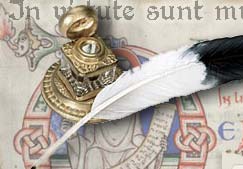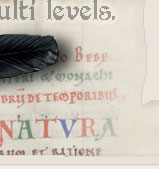|
Pages: 1 2 [3] 4 5 6 7 8 ... 10
21
« Last post by Diane on October 01, 2013, 12:42:53 AM »
Here's an example of the same principle ~ this one might appeal to "Phil the Rodent". http://www.mhs.ox.ac.uk/astrolabe/exhibition/sun_moon.htm
22
« Last post by Diane on September 24, 2013, 03:06:38 AM »
I've just seen this quote.
"Dr. Leonell Strong ...said that the solution to the MS cipher was a “peculiar double system of arithmetical progressions of a multiple alphabetâ€Â.
I thought I'd mention this in case any reader thought it informed my question.
Strong believed the "MS to be written by the 16th century English author Anthony Ascham, whose works include A Little Herbal, published in 1550"
impossible now we have the radiocarbon dating.
23
« Last post by Diane on September 20, 2013, 05:58:51 AM »
Hi Aaron,
Don Hoffmann assumes Voynichese is a technical notation.
I fell over the idea after noticing Julian Bunn's grids look like a weaving pattern.
I tried other technical instructions which have the option of expression by condensed notation or with a graph/tabular grid.
These included
- certian types of medical prescriptions;
- systems for generating scents from a limited list of ingredients;
- weaving and (as you see)
- knitting.
What I'd be glad to know is whether the principle seems to others to suit the statistical properties of Voynichese as well or better than a polyglot text would.
Either of those is possible; no objection from the internal evidence.
If the idea's important or not, I can't say, but if so Don Hoffmann is to be credited. He did the real hard work first (and most).
My interest is in nothing much but the manuscript.
I'm too old for ambition, too unglam to nod wisely on tv, and too easily disgusted by the intellectually dishonest.
But back to the conundrum.. do 'words' of such a kind suit Voynichese' statistical properties?
Cheers
(edited Sept 21st. 2013)
24
« Last post by Aaron on September 20, 2013, 12:27:15 AM »
So just to sum up your lengthy proposition:
Content analysis using different assumptions for the type of content definitely sounds important.
Even something as simple as which language something is written in can affect stuff like frequency analysis. If it's a full blown unique notation, then assuming a standard language would certainly put us way off the mark.
There is an alternative though: what if someone were to write something in a mix of 2-3 different languages? Or heck, a mix of language and notation? It's quite possible we're not looking at a single "consistent" language. I know there are several people out there who are multilingual and often freely interchange what language they are using mid-sentence so people have trouble overhearing them.
25
« Last post by Diane on September 17, 2013, 10:13:49 PM »
Hi, Lately it has been suggested (by me) and proposed (by Don Hoffmann) that Voynichese is neither prose nor poetry, but a technical notation composed of little or nothing but acronyms and numbers. Don's model is pharmaceutical recipes; mine was 'recipes' in various types of textile production, but the same principle applies for scientific notations - e.g. in geography, surveying or maths. Here's an example - non-std knit notation though.  Since it's not prose interrupted by Tironian notation, I hesitate to call it an abbreviated text, but know no other term. I realise that texts of that kind would probably defy translation. But I'd like to know how testing them as Voynichese has been tested (redundancy, entropy, n-grams) might change our view of the Voynichese statistics. I suppose expectations about e.g. proportion of numerical to alphabetic signs might alter, and perhaps expected frequency of consonants against vowels? If I'm to understand any responses, it's probably a good idea to let you know that I learned the definition of "n-grams" a couple of hours ago.  Diane
26
« Last post by Aaron on September 06, 2013, 11:46:55 AM »
So I read through a new webcomic recently, and apparently the creator is a huge fan of cryptography: http://www.sandraandwoo.com/2013/07/29/0500-the-book-of-woo/I hope you all like the challenge!  It's similar to the Voynich Manuscript.
27
« Last post by Cat on September 06, 2013, 11:20:36 AM »
Here 'tis (From a lucky line of discovery I tried several nights ago):
Know the start letters from the keywords(I brute-forced them), which change with every comma.
Write down the individual keyword letter at the beginning of each number group -- like a bingo call.
Each number is actually a letter exactly "x" units away,added or subtracted, on an alphabet range (included below for covienience).
Keyword letters + number letters are both needed, in order, for plaintext.
Also each keyword changes with every row. Therefore you need the correctly spaced lines (not smushed together to save space) from the Project Gutenburg Internet Archive Pamplet, or you are sunk.
I am posting because while I have a definate method that works for both Ciphers 1 and 3, I do not have all the keywords. Beale 1 seems to be a "Masquerade"-type hunt. Dependant on date and time. Beale 3 is a group of wills, each line listing a seperate family, with the keyword being their family member.
A B C D E F G H I J K L M N O P Q R S T U V W X Y Z-A B C D E F G H I J K L M N O P Q R S T U V W X Y Z
BEALE CIPHER 1 ROW 1 KEYWORD PHRASE "MAY ONE":
Row 1 Raw Numbers:
71, 194, 385, 1701, 89, 76, 11, 83, 1629, 48, 94, 63, 132, 16, 111, 95, 84, 341,
Matched with phrase:
M-71, A-194, Y-385, O-1701, N-89, E-76, M-11, A-83, Y-1629, O-48, N-94, E-63, M-132, A-16, Y-111, O-95, N-84, E-341,
Raw Plaintext:
Mtn, Az ke,Y be t, On io m,N vu,E x k,M ln, Aid, Y x ea q, O k w,Nw r, Ez b, Ml pk, Az u Y zx z, O ft, N v r,E b id
BEALE CIPHER 3 ROW 1 Keyword "BEALE":
B317, E8, A92, L73, E112, B89, E67, A318, L28, E96, B107, E41, A631, L78, E146, B397, E118, A98,
Beau, Elary, Leo, Edd C, Bk, Selma, Cas, Lit, Evy, Babie Ada Uxb, L St., Edil, Beki, Eddy, Ari
BEALE CIPHER 3 ROW 2 Keyword "JAKOB":
J114, A246, K348, O116, B74, J88, A12, K65, O32, B14, J81, A19, K76, O121, B216, J85, A33, K66, O15,
J, kim, Acef, K hose, Oppi, Bif Jr, rAby, KepOlm Jr, kAb, j KreOn, m nB dav J, reAdd, Kee, Ont
BEALE CIPHER 3 ROW 3 Keyword "BILLY":
B108, I68, L77, L43, Y24, B122, I96, L117, L36, Y211, B301, I15, L44, L11, Y46, B89, I18, L136, L68,
Babj, Io, aLee, Lio, Yau B, add, IroL, mke, Li f, Yazz, Beb cImeL, mkL, Yue, ButI, hal, mor, Lrt
28
« Last post by Diane on August 29, 2013, 12:18:06 PM »
Nimrod, from Elgar's Enigma variations http://www.8notes.com/scores/7105.asp
29
« Last post by Aaron on August 28, 2013, 10:56:12 AM »
That's a good question. Who knows of a good source for scans/photos of Elgar's original handwritten pieces of music?
30
« Last post by Diane on August 27, 2013, 10:10:08 AM »
OK - I'm Dorabella
Fairly young, a bit musical. Probably learned to play the pianoforte among accomplishments proper to a middle-class gel. Not stupid, but my knowledge of ciphers and things runs to the language of flowers, and how to flirt with a fan and stamps.
A minister's daughter, so unused to worker's use of 'f' words. Mr. Elgar is introduced to me, and I begin a conversation in which we find we are kindred spirits. Something initiates a train of thought which leads Elgar to provide me with a page of curly marks that I cannot understand.
Likely scenario? As a polite gesture to his eminence, and his profession, I say something like, O Mr. Elgar, I did so enjoy hearing your ....(x piece of music)... that I implored Papa to obtain the sheet music for me.
Says Elgar, 'I should be delighted to hear you play it'.
Say I, who never expected to be taken seriously,
'... But I confess that while I can read the notes I should play, my fingers become terribly tangled and as yet I haven't been able to play it as you deserve it should be'.
Says Elgar, I daresay I can provide you with an alternative notation, one easier on your delightful digits, though it may prove as much of a puzzle in another way.
At which I flutter my fan, delighted to be off the hook and to be able to say over dinner that this eminent gentleman has been so kind and condescending.
The bit of paper, when it arrives, is certainly beyond me, because I've never seen a piece of Elgar's music written in my life.
So - how about an overlay, point to point, on Elgar's sheet music?
*retires, fluttering ignorant eyelashes*
Pages: 1 2 [3] 4 5 6 7 8 ... 10
|



 Recent Posts
Recent Posts
